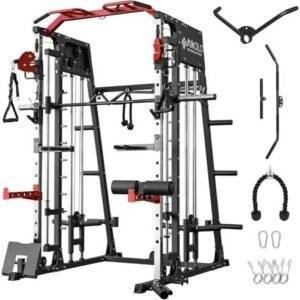In the ever-evolving realm of sports and fitness, the necessity for well-structured athletic training programs has grown exponentially as athletes aim to maximize their performance while minimizing the risk of injury. These programs not only serve as a foundation for physical conditioning but also encompass a holistic approach to an athlete’s development, integrating psychological resilience, nutritional guidance, and recovery strategies. This article delves deep into the intricacies of effective athletic training programs, offering comprehensive insights backed by research and expert opinions. We will explore the essential components that contribute to a successful training regimen, including sport-specific training modalities, periodization strategies, the role of technology in monitoring progress, and the importance of individualized approaches tailored to athletes’ unique needs. Whether you are a coach, an athlete, or a sports enthusiast, understanding these elements can help to elevate performance standards and promote long-term athletic success. By examining the cutting-edge practices in the field, we aim to provide an invaluable resource that empowers stakeholders at all levels to cultivate optimal training environments, ensuring that each athlete can reach their full potential.
Table of Contents
- Understanding the Foundations of Successful Athletic Training Programs
- Key Components of Periodization in Athletic Training
- Incorporating Nutrition and Recovery Strategies for Optimal Performance
- Leveraging Technology and Data Analytics for Enhanced Training Outcomes
- Future Outlook
Understanding the Foundations of Successful Athletic Training Programs
Building a successful athletic training program requires a deep understanding of the core principles that underpin athletic performance and injury prevention. These foundations can be categorized into several key elements:
- Individual Assessment: Each athlete needs a tailored training plan based on their unique strengths, weaknesses, and goals.
- Balanced Training Regimen: Programs should incorporate a mix of strength, flexibility, endurance, and sport-specific skills.
- Progressive Overload: To stimulate muscle growth and improve performance, athletes must gradually increase the intensity of their training.
- Recovery Practices: Adequate rest and recovery strategies must be in place to prevent burnout and injuries.
- Nutrition and Hydration: Proper diet plays a pivotal role in performance and recovery, necessitating an educational component in training programs.
A well-rounded training program also relies on continual evaluation and adaptation. The following table outlines essential aspects of program evaluation:
| Aspect | Importance | Frequency |
|---|---|---|
| Performance Metrics | Tracks progress and identifies strengths | Every month |
| Injury Reports | Helps in adjusting the training load | Weekly |
| Training Feedback | Ensures athletes’ needs are being met | Bi-weekly |
Key Components of Periodization in Athletic Training
Periodization is a systematic approach to training that helps athletes optimize performance through planned variations in training intensity, volume, and recovery. At its core, effective periodization incorporates several key components, including macrocycles, mesocycles, and microcycles. Macrocycles represent the overarching training plan, typically spanning a year or a season, aimed at achieving peak performance during a specific competition. Within each macrocycle, mesocycles break the training into smaller phases, focusing on specific goals such as hypertrophy, strength, and power. Microcycles, the smallest units, often last a week and allow for daily variations in training loads and recovery strategies, which are essential for preventing overtraining and promoting adaptations.
Another critical element is the principle of progressive overload, which dictates that as an athlete adapts to a specific training stimulus, the intensity or volume must be gradually increased for continual progress. Additionally, managing training frequency, duration, and rest periods is vital to ensure athletes recover adequately while maximizing performance gains. Below is a table summarizing these components:
| Component | Description |
|---|---|
| Macrocycle | Year-long or seasonal training plan focused on peak performance. |
| Mesocycle | Phases of training within a macrocycle targeting specific fitness goals. |
| Microcycle | Weekly training schedule with daily variations in intensity and volume. |
| Progressive Overload | Gradual increase in training load to foster adaptation. |
Incorporating Nutrition and Recovery Strategies for Optimal Performance
To achieve peak athletic performance, integrating nutrition and recovery strategies is essential. A well-balanced diet tailored to the specific demands of an athlete can significantly impact both performance and recovery times. Focus on incorporating a variety of nutrient-rich foods including:
- Lean proteins: vital for muscle repair and growth.
- Complex carbohydrates: provide sustained energy during training and competitions.
- Healthy fats: support hormonal balance and overall health.
- Hydration: crucial for maintaining performance levels and preventing fatigue.
Recovery strategies are equally important, enabling athletes to bounce back stronger after rigorous training sessions. The following practices can enhance recovery and minimize injury risk:
- Active recovery: light activities on rest days to promote blood flow.
- Sleep: prioritizing quality sleep to facilitate muscle repair and cognitive function.
- Stretching and foam rolling: techniques that improve flexibility and reduce muscle tightness.
- Nutrition timing: consuming the right nutrients post-exercise to optimize muscle recovery.
Sample Recovery Nutrient Timeline
| Time | Nutrient | Source |
|---|---|---|
| Immediately Post-Workout | 25g Protein | Protein shake, Greek yogurt |
| 30-60 Minutes Post-Workout | 50g Carbohydrates | Brown rice, sweet potato |
| 2 Hours Post-Workout | Balanced Meal | Chicken, quinoa, vegetables |
Leveraging Technology and Data Analytics for Enhanced Training Outcomes
In today’s competitive sports environment, the adoption of cutting-edge technology and advanced data analytics is vital for optimizing training outcomes. Coaches and trainers can utilize tools such as wearable devices, motion capture systems, and performance-tracking software to gather real-time data on athletes’ performance. This data can help identify individual strengths and weaknesses, enabling a more tailored training approach. The integration of technology allows for:
- Personalized Training Plans: Based on specific metrics and performance history.
- Real-time Feedback: Instant assessments during workouts, facilitating immediate corrections.
- Trend Analysis: Evaluating historical data to track progress over time.
Furthermore, data analytics provides a platform for strategic decision-making that can profoundly influence training methodologies. By analyzing performance trends and physiological responses, trainers can better understand the impact of various training regimens and recovery protocols. The use of predictive analytics can also aid in injury prevention, as it helps to identify risk factors associated with excessive training loads. The following table illustrates the key benefits of implementing data analytics in athletic training:
| Benefit | Description |
|---|---|
| Informed Decision Making | Data-driven insights for program adjustments. |
| Enhanced Performance Monitoring | Track athlete progress and adapt training accordingly. |
| Improved Recovery Strategies | Data helps in developing optimal rest and recovery protocols. |
Future Outlook
the journey toward achieving peak athletic performance is a multifaceted endeavor, one that requires a well-structured and comprehensive training program. The insights provided in this article underscore the significance of a holistic approach that integrates physical conditioning, mental fortitude, and nutritional strategies. By understanding the critical components of effective athletic training, including tailored workout regimens, injury prevention protocols, and the psychology of sports performance, coaches and athletes alike can cultivate an environment conducive to success.
As we move forward, it is vital to remain adaptable and responsive to the evolving landscape of sports science and training methodologies. Continuous education, regular assessment, and refinement of training strategies will empower athletes to unlock their full potential. Moreover, fostering collaborative relationships between trainers, physiologists, nutritionists, and athletes can lead to innovative practices that enhance overall performance.
Ultimately, the goal of any athletic training program should not only be to prepare athletes for competition but also to instill a lifelong commitment to health, resilience, and excellence. By implementing the principles discussed in this article, stakeholders in the world of sports can contribute to a new generation of athletes who not only excel in their disciplines but also inspire futures filled with promise and achievement. Embracing a comprehensive and effective approach to athletic training is a commendable investment in the athletes of today and the champions of tomorrow.




